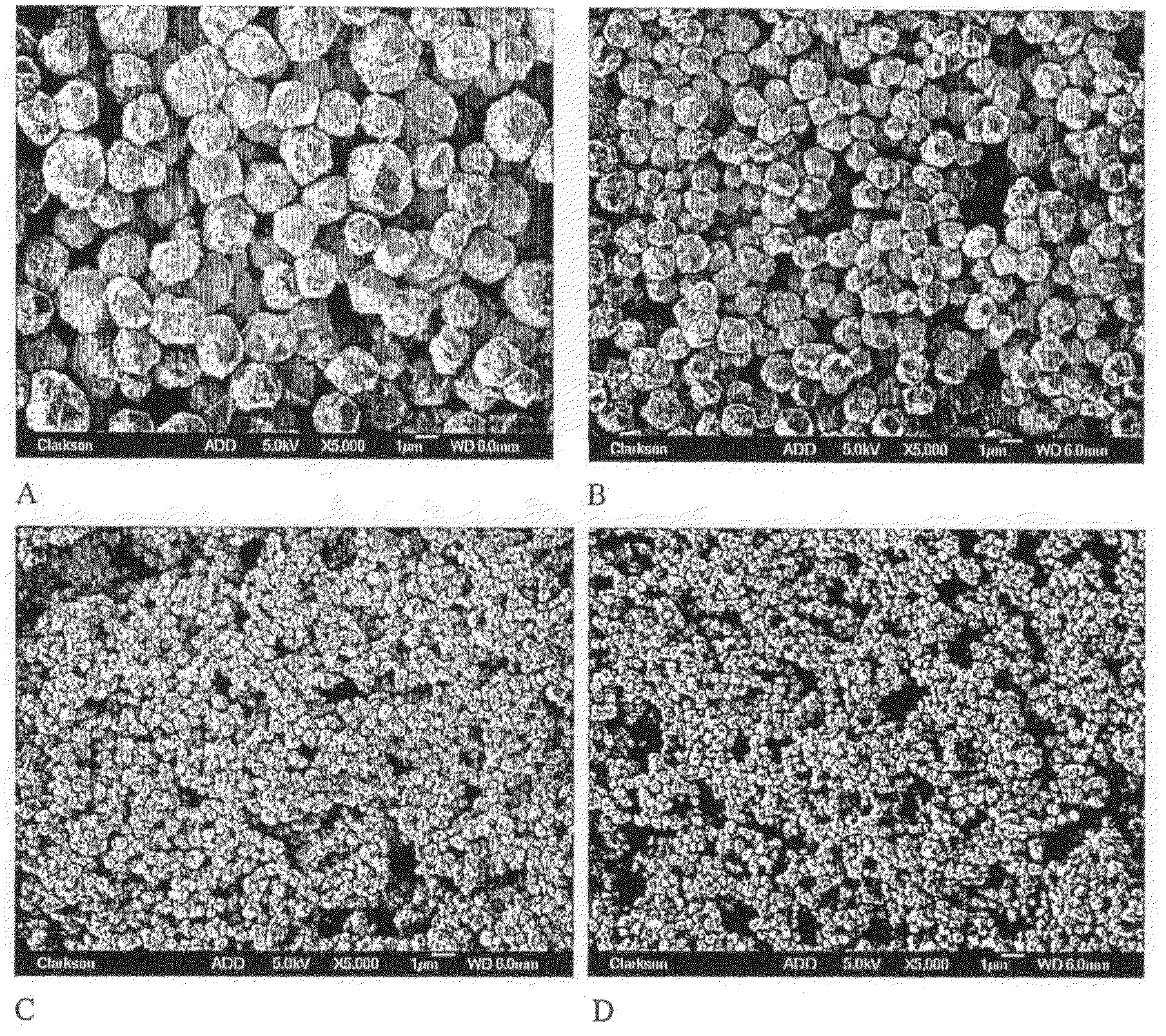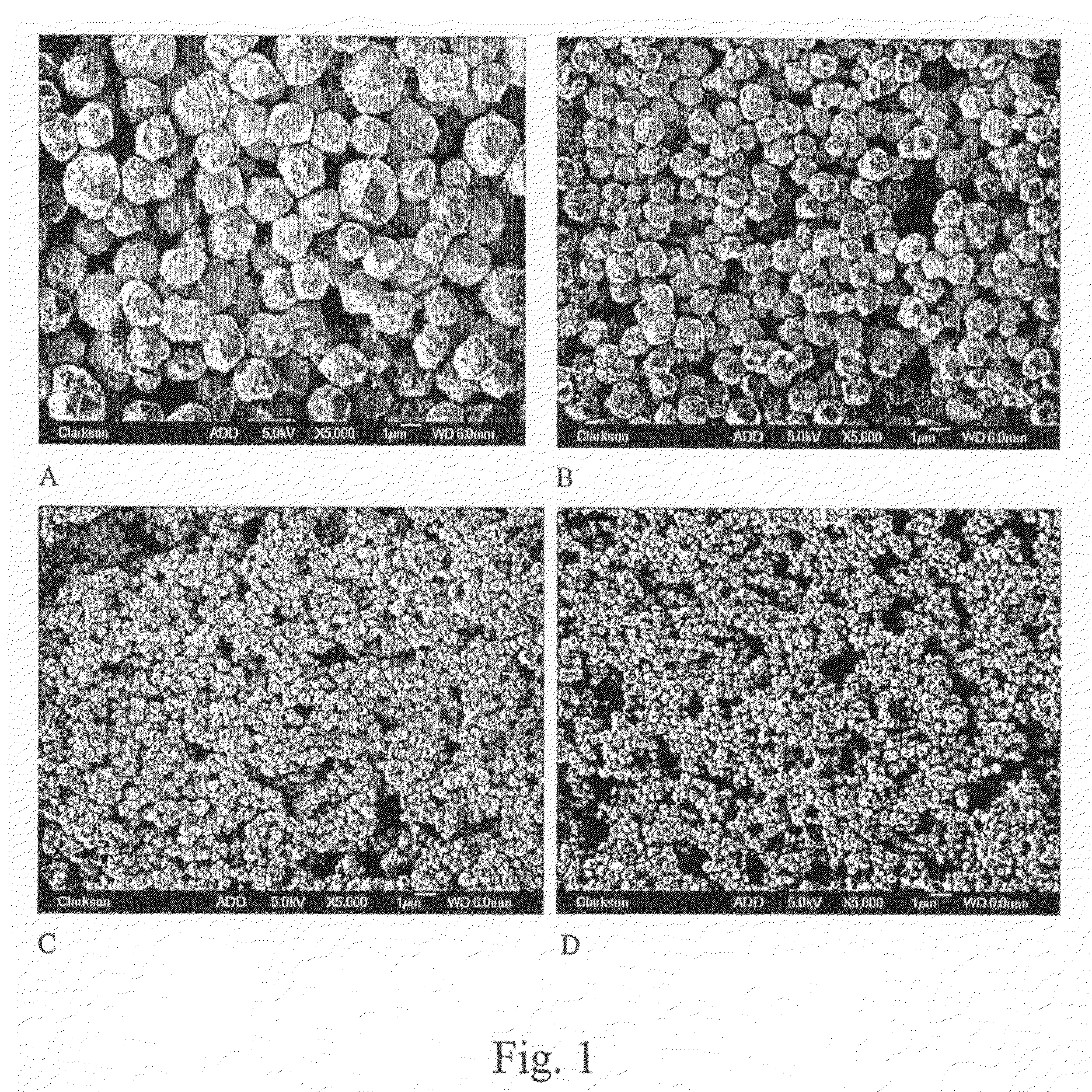Polyol-based method for producing ultra-fine metal powders
a technology of metal powder and polyol, which is applied in the direction of transportation and packaging, coatings, chemical instruments and processes, etc., can solve the problems of low concentration of metal precursors, wide size distribution of metallic powder produced using these procedures, and excessive consumption of organic solvents per unit weight of metallic powder, etc., to achieve high crystallinity and oxidation resistance, low degree of agglomeration, and tight size distribution
- Summary
- Abstract
- Description
- Claims
- Application Information
AI Technical Summary
Benefits of technology
Problems solved by technology
Method used
Image
Examples
example 1
Copper Particle Synthesis
[0053]All experiments were carried out in a 1-liter, 4-necked round flask equipped with a Dean Stark trap and a reflux condenser. The stirring was provided by a two-inch Teflon blade connected to a variable speed mixer. The amount of cupric carbonate used in the precipitation process was in general kept at 200 g (1.62 mole) although smaller or larger amounts were occasionally used as well (e.g., 87 g or 300 g). CuCO3 was added to 500 ml of polyol or a polyol mixture, containing 15 g PE (for 200 g CuCO3). The dispersant agent (PE) was initially added to the polyol(s) and heated at a low power (10%) with a heating mantle to bring the temperature to 70° C. The required amounts OfCuCO3 were added into the flask at 80-85° C. after PE was fully dissolved. The CuCO3 / polyol mixture was stirred at 500 RPM in all experiments. The mixture was then heated at 50% power until the temperature reached 180-185° C. The copper particles obtained were washed three times with et...
example 2
Particle Characterization
[0054]The morphology of the copper particles was investigated by scanning electron microscopy (SEM) using a JEOL JSM-6300 scanning microscope at 15 kV accelerating voltage and the magnification between 2500 and 10000. Copper powders were also analyzed by field emission scanning electron microscopy (FE-SEM) with 5 kV accelerating voltage and the same range of magnification using a JEOL JSM-7400F field emission scanning electron microscope.
[0055]In order to evaluate the effect of pH on the formation of Cu particles in polyols, variable amounts of triethanolamine (TEA) were added into the dispersion of CUCO3 prior to heating, as shown in Table 1. The reaction time in the presence of TEA varied between 3 and 4 hours; the addition of more base tending to speed up the reaction. The particles sizes shown in Table 1 were obtained by averaging the size of minimum 50 particles generated in each experiment. Images of copper particles produced in these experiments, obta...
example 3
Preparation of Ultra-Fine Nickel Particles
[0066]All experiments were carried out in a 1-liter 4-necked flask equipped with a refluxing condenser above a Dean-Stark trap and 7″ extension. Stirring was provided by a two-inch Teflon blade connected to a variable speed mixer. The amount of nickel carbonate used in the precipitation process was in general kept at 140 g (1.18 mole). NiCO3 was added to 500 ml of a polyol mixture, composed of 50% PG, 50% DEG and 7 g PE. The dispersing agent, PE, was added to the polyol and heated to 70° C. with a heating mantle. The required amount of NiCO3 was added at 80-85° C., after the PE had fully dissolved. The NiCO3 / polyol mixture was stirred at 500 RPM in all experiments. The mixture was continually heated (75% power to the heating mantle) until reduction was complete. The nickel powder was washed three times with ethanol (3×400 ml) and was filtered with a vacuum system using Whatman #50 filter paper. The powder was then dried overnight at 100° C. ...
PUM
| Property | Measurement | Unit |
|---|---|---|
| diameter | aaaaa | aaaaa |
| diameter | aaaaa | aaaaa |
| degree of crystallinity | aaaaa | aaaaa |
Abstract
Description
Claims
Application Information
 Login to View More
Login to View More - R&D
- Intellectual Property
- Life Sciences
- Materials
- Tech Scout
- Unparalleled Data Quality
- Higher Quality Content
- 60% Fewer Hallucinations
Browse by: Latest US Patents, China's latest patents, Technical Efficacy Thesaurus, Application Domain, Technology Topic, Popular Technical Reports.
© 2025 PatSnap. All rights reserved.Legal|Privacy policy|Modern Slavery Act Transparency Statement|Sitemap|About US| Contact US: help@patsnap.com



